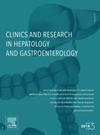使用总结机器学习算法的自动小肠胶囊内窥镜报告:SUM UP研究。
IF 2.4
4区 医学
Q2 GASTROENTEROLOGY & HEPATOLOGY
Clinics and research in hepatology and gastroenterology
Pub Date : 2025-01-01
DOI:10.1016/j.clinre.2024.102509
引用次数: 0
摘要
背景与目的:深度学习(DL)算法在小肠(SB)胶囊内窥镜(CE)血管病变检测中表现出优异的诊断性能,包括高(P2)、中(P1)或低(P0)出血潜能的血管异常,同时显著缩短了读取时间。我们的目标是通过使用机器学习(ML)分类器来表征血管异常,并选择最相关的图像插入到报告中,从而提高DL算法的性能。材料和方法:创建了一个包含75个SB CE视频的训练数据集,其中包含401个感兴趣序列,其中包含1,525张各种血管病变图像。测试了几种图像分类算法,以区分“典型血管发育不良”(P2/P1)和“其他血管病变”(P0),并在重复图像序列中选择最相关的图像。随后在73个完整的SB CE视频记录的独立测试数据集上评估了最佳拟合算法的性能。结果:DL检测后,随机森林(RF)方法的特异性为91.1%,接收工作特征曲线下面积为0.873,区分P2/P1和P0病变的准确率为84.2%,同时减少了83.2%的报告图像数量。在独立测试数据库中,应用射频后,输出数量减少了91.6%,从216个(IQR 108-432)减少到12个(IQR 5-33)。RF算法与初始的传统(人类)报告达到98%的一致性。在DL检测后,RF方法可以更好地表征和准确选择相关(P2/P1) SB血管异常的图像,用于CE报告,而不会损害诊断准确性。这些发现为自动化SB CE报告铺平了道路。本文章由计算机程序翻译,如有差异,请以英文原文为准。
Toward automated small bowel capsule endoscopy reporting using a summarizing machine learning algorithm: The SUM UP study
Background and objectives
Deep learning (DL) algorithms demonstrate excellent diagnostic performance for the detection of vascular lesions via small bowel (SB) capsule endoscopy (CE), including vascular abnormalities with high (P2), intermediate (P1) or low (P0) bleeding potential, while dramatically decreasing the reading time. We aimed to improve the performance of a DL algorithm by characterizing vascular abnormalities using a machine learning (ML) classifier, and selecting the most relevant images for insertion into reports.
Materials and methods
A training dataset of 75 SB CE videos was created, containing 401 sequences of interest that encompassed 1,525 images of various vascular lesions. Several image classification algorithms were tested, to discriminate “typical angiodysplasia” (P2/P1) and “other vascular lesion” (P0) and to select the most relevant image within sequences with repetitive images. The performances of the best-fitting algorithms were subsequently assessed on an independent test dataset of 73 full-length SB CE video recordings.
Results
Following DL detection, a random forest (RF) method demonstrated a specificity of 91.1 %, an area under the receiving operating characteristic curve of 0.873, and an accuracy of 84.2 % for discriminating P2/P1 from P0 lesions while allowing an 83.2 % reduction in the number of reported images. In the independent testing database, after RF was applied, the output number decreased by 91.6 %, from 216 (IQR 108–432) to 12 (IQR 5–33). The RF algorithm achieved 98.0 % agreement with initial, conventional (human) reporting. Following DL detection, the RF method allowed better characterization and accurate selection of images of relevant (P2/P1) SB vascular abnormalities for CE reporting without impairing diagnostic accuracy. These findings pave the way for automated SB CE reporting.
求助全文
通过发布文献求助,成功后即可免费获取论文全文。
去求助
来源期刊

Clinics and research in hepatology and gastroenterology
GASTROENTEROLOGY & HEPATOLOGY-
CiteScore
4.30
自引率
3.70%
发文量
198
审稿时长
42 days
期刊介绍:
Clinics and Research in Hepatology and Gastroenterology publishes high-quality original research papers in the field of hepatology and gastroenterology. The editors put the accent on rapid communication of new research and clinical developments and so called "hot topic" issues. Following a clear Editorial line, besides original articles and case reports, each issue features editorials, commentaries and reviews. The journal encourages research and discussion between all those involved in the specialty on an international level. All articles are peer reviewed by international experts, the articles in press are online and indexed in the international databases (Current Contents, Pubmed, Scopus, Science Direct).
Clinics and Research in Hepatology and Gastroenterology is a subscription journal (with optional open access), which allows you to publish your research without any cost to you (unless you proactively chose the open access option). Your article will be available to all researchers around the globe whose institution has a subscription to the journal.
 求助内容:
求助内容: 应助结果提醒方式:
应助结果提醒方式:


